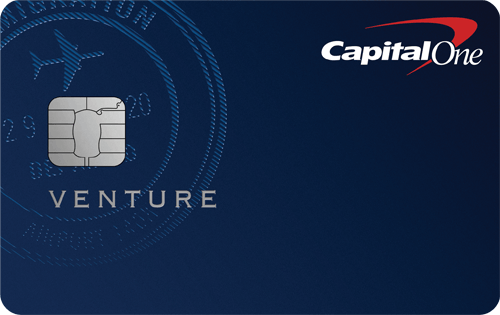In this article

Capital One Miles are a flexible rewards currency with plenty of redemption options. Today, we’ll run through some of the best strategies to maximize the value of your Capital One miles.
Earning Capital One Miles
Some popular cards that earn Capital One Miles include:
Capital One Venture Rewards Credit Card
75,000 Miles once you spend $4,000 on purchases within 3 months from account opening
Capital One Venture X Rewards Credit Card
100,000 Miles when you spend $10,000 on purchases in the first 6 months from account opening
Capital One Venture X Business
LIMITED-TIME OFFER: Earn 400,000 bonus miles: 200K miles when you spend $30K in the first 3 months, and an additional 200K miles when you spend $150K in the first 6 months
Another interesting note is that you can turn cash back earned on Capital One cards into miles if you have a miles-earning card like the Capital One Venture Rewards Credit Card or Capital One Venture X Rewards Credit Card.
This means the cash back earned on the cards, like the Capital One Savor Cash Rewards Credit Card, could become miles. This is one of the advantages of the Capital One Duo.
Capital One Spark Miles for Business
Earn a one-time bonus of 50,000 miles - equal to $500 in travel - once you spend $4,500 on purchases within 3 months from account opening
1. Statement Credits for Non-Travel (0.5 CPM)
Using Capital One miles as a straight cash back or general statement credit gives you the lowest value. You would need 10,000 miles to cover a $50 credit card charge. This means you only get 0.5 CPM ($0.005 cents per mile).
Treat this as a last resort — if you need to close your account or in the case of an emergency — but otherwise, there are better options.
2. Shopping & Redeem Miles (up to 0.8 CPM)
The next option, and still not ideal, is using your miles to shop through partner platforms like Amazon or PayPal. Capital One lets you link your rewards to Amazon or use them at PayPal checkout. The downside is that you’re getting subpar value of only about 0.8 cents per mile.
This means 10,000 miles would only cover $80 towards your Amazon cart — less than some travel alternatives.
Unless you have a small stash of miles that you absolutely can’t use for travel, it’s better to avoid this.
3. Gift Cards (up to 1 CPM)
The redemption value starts to hit the baseline at this level. Using miles for gift cards will generally get you about 1 cent per mile in value.
For instance, 10,000 miles can typically be traded for a $100 gift card to various retailers or restaurants. That’s a much better deal than cashing out or using miles on Amazon.
However, there are a couple of caveats. First, gift cards sometimes go on sale or can be bought at a discount, so spending miles at face value could be less efficient than just buying a discounted gift card with cash. Second, you’re converting travel rewards into retail spending; unless you truly need that gift card, you could have put those miles toward travel.
On the positive side, gift card redemptions are easy and straightforward, and if you’re certain you won’t travel, getting 1 cent per mile this way is far better than letting your miles languish or redeeming for 0.5 CPM. If you decide to go this route, aim for gift cards you’d spend money on anyway.
Overall, gift cards are an “okay” use of Capital One Miles — not great, but also not bad.
4. Travel Redemptions via Capital One (1 CPM)
This hits the baseline of 1 cent per mile, and there are two ways to do this:
- Book Travel Through the Capital One's travel booking site Portal: You can use your miles to directly book flights, hotels, or car rentals on Capital One’s travel site, paying with miles at checkout. The cost in miles is simply 100 * (cash price in dollars). For example, a $300 flight will cost 30,000 miles.
- Redeem for Recent Travel Purchases: You book travel on your own with your Capital One card (through any airline, hotel, travel website, etc.), then afterward redeem miles to get a statement credit for that purchase. This also gives 1 cent per mile value – e.g. 30,000 miles erases a $300 hotel charge. You can do this for travel purchases made in the last 90 days.
Both methods give the same value, 100,000 miles = $1,000 towards travel, for 1 CPM.
Given the choice, you are generally better off booking directly and redeeming against the charges. Some hotel groups will not honor elite status perks if the booking is not Capital One's travel booking siteital One Travel would be a third-party booking in this case). Others might not offer night credits or reward additional points. Similarly, making changes to your flights is usually easier when you book directly.
To maximize value: use your miles for travel, but consider booking direct and redeeming miles for a statement credit, especially for flights or hotel stays where loyalty benefits matter.
Both options get reasonable value and are an easy, beginner-friendly way, and the minimum value you should aim for with Capital One. This is perfect if you want something straightforward and don’t want to deal with blackout restrictions or finding availability.
5. Transferring to Airline/Hotel Partners (up to 2+ CPM)
Transferring Capital One Miles to airline and hotel partner loyalty programs is one of the best ways to maximize their value, making it a top redemption option. Capital One offers a robust selection of 18 travel partners (15 airlines and 3 hotel programs), with most transfers occurring at a 1:1 ratio—meaning 1 Capital One Mile becomes 1 airline mile or hotel point.
If you're looking for premium or aspirational travel, leveraging transfer partners can be especially rewarding.
Airline Partners:
- Aeromexico Club Premier
- Air Canada Aeroplan
- Air France-KLM Flying Blue
- Avianca LifeMiles
- British Airways Executive Club
- Cathay Pacific Asia Miles
- Emirates Skywards
- Etihad Guest
- EVA Air Infinity MileageLands
- Finnair Plus
- Japan Airlines (4:3 ratio)
- Qantas Frequent Flyer
- Qatar Airways Privilege Club
- Singapore Airlines KrisFlyer
- TAP Air Portugal Miles&Go
- Turkish Airlines Miles&Smiles
Hotel Partners:
- Accor Live Limitless
- Choice Privileges
- Preferred Hotels & Resorts
- Wyndham Rewards
Most transfers occur at a 1:1 ratio, though some exceptions exist. For instance, Accor Live Limitless transfers at a 2:1 ratio, meaning 2 Capital One Miles convert into 1 Accor point.
This means your 100,000 Capital One Miles can become 100,000 miles in programs like Air Canada Aeroplan, Turkish Airlines Miles&Smiles, or British Airways Avios, opening up access to premium redemptions.
Maximizing Transfer Value
The real trick lies in how you redeem in the partner program. If used strategically, transferred miles can easily exceed the baseline 1 cent per mile value you’d get when redeeming through Capital One's travel booking site.
Premium cabin redemptions, in particular, can yield 5 to 10 cents per mile, making transfers a game-changer for luxury travel. Some of the best redemptions include:
- ANA First and Business Class via Virgin Atlantic
- Emirates First Class
- Singapore Airlines First Class
These examples illustrate the upside: by transferring Capital One Miles into the right frequent flyer program, you can unlock far more value. This is how savvy travelers turn 75,000 miles into $1,500+ flights or 100,000 miles into $10,000+ first-class experiences.
Considerations & Flexibility
That said, maximizing transfer partners requires effort and flexibility. You’ll need to:
- Find award availability (seats bookable with miles)
- Navigate different airline rules and redemption charts
- Be flexible with dates and routings
Not all transfers will yield great value—if you transfer 1:1 to an airline and then redeem for a low-value ticket, you might end up worse off than just using the flat 1 cent per mile value through Capital One's travel booking site.
For this reason, transfers are best suited for travelers who enjoy planning and optimizing redemptions. If that’s you, Capital One Miles become an incredibly powerful tool for premium travel experiences.
Key Considerations and Strategies for Maximizing Capital One Miles
Now that we’ve ranked the options, let’s discuss how to strategize your redemptions to get the most out of every mile. Whether you’re just starting with miles and points or a seasoned pro, these tips will help you maximize value:
- Decide When to Transfer vs. When to Use Fixed-Value: A key strategy for advanced users is knowing when to transfer your miles to partners and when to simply redeem at 1 cent. Not every flight or hotel is a good candidate for using transfer partners. A general rule: if the cash price is low, just pay out of pocket or use the miles to cover the charge.
If the cash price is high (or there’s a sweet spot award price), look into transferring. For example, if a last-minute ticket or business class seat costs $1,000 cash but you can find an award for 50,000 miles, transferring could save you a lot (you’d be getting 2 cents per mile, $1,000 value for 50k miles).
Always compare the mile cost vs cash cost. A good strategy is to search airline award availability before deciding to transfer; if you find a saver award that costs fewer miles than the fixed-value equivalent, transferring is the better move. If award seats are unavailable or require an enormous amount of miles, you can fall back on the 1 cent per mile redemption.
- Research Transfer Partner Sweet Spots: If you want to dive into advanced redemptions, take time to learn about a few of Capital One’s best transfer partners and their “sweet spot” awards. Not all partner programs are equal – some will give you phenomenal value. Turkish Miles & Smiles is great for domestic U.S. awards, Air Canada Aeroplan has competitive award rates and no fuel surcharges, Avianca LifeMiles is known for Star Alliance bargains (like Lufthansa First with minimal fees), and Flying Blue frequently has promo rewards.
Identify 1 or 2 programs that align with your travel goals (for instance, if you travel to Europe often, look at Aeroplan or Flying Blue; for Asia, maybe Singapore KrisFlyer).
You don’t have to master all 15 partners – start with the ones that you can actually use. Having a plan will help you know when it’s worth transferring. Also remember that all transfers are one-way (you can’t convert partner miles back to Capital One), so transfer once you have an award in mind. And be mindful of partner quirks like expiration dates or booking fees.
- Be Flexible and Plan Ahead: The highest-value redemptions (like international business or first class awards) often require flexibility. Plan your aspirational trips in advance and be open with dates or routes to find saver availability. Use tools or alerts to spot award seats. If you can travel in off-peak times or take a slightly longer route, you might secure that 5 cents per mile value redemption that others miss. Flexibility can also mean being ready to pounce on a limited-time award sale.
- Gauge Your Own Needs: Ultimately, the way you redeem should match your travel needs and lifestyle. If you have a large family and mainly travel economy, chasing a first-class suite to Asia might not be practical – you might be better off using miles at 1 cent to cover part of your Disney vacation flights or hotels. Be realistic: if you know you’ll never bother with complicated redemptions, don’t stress about it – just use the miles for travel credits and enjoy the simplicity. If you do want to maximize every last cent of value, then invest the effort to learn and plan, because the payoff can be huge for those who take the time.
- Mix Strategies for Best Results: One beautiful thing about Capital One miles is the ability to mix strategies. You aren’t locked into one redemption method. For example, you could transfer 60k miles to book a business class flight for an upcoming special trip (high value), and use another 20k miles to cover a $200 hotel bill on a different trip (easy and decent value). This flexibility means you can optimize each redemption: use miles at the fixed rate when that makes sense and save some for transfers when those will net a better deal. By diversifying how you redeem, you ensure no mile gets wasted. You can even combine forces with other transferable point currencies if you have them to reach an award threshold, but that’s beyond the scope of this guide.
The key point is Capital One’s program lets you tailor redemptions to your needs – take advantage of that. If an award ticket isn’t available or is too expensive in miles, you always have the safety net of the 1 cent per mile redemption. This dual approach makes Capital One miles extremely user-friendly and valuable.
For different types of users:
- If you’re a beginner or value simplicity: Focus on earning miles and using them at the 1 cent rate for travel. For example, book your flights for your annual vacation, then cover those charges with miles. It’s effectively a 2% back travel card, which is decent. You won’t be disappointed with the value, and you avoid the complexity altogether. This approach ensures you get some value while minimizing headaches.
- If you’re an avid traveler or miles & points enthusiast: Take the time to familiarize yourself with a few of the best transfer partners. Plan your redemptions around high-value awards – maybe you save your miles to fly business class to a destination on your bucket list, or to cover a first class experience you’d never pay out of pocket. By doing so, you could get double, triple, or even 5x+ the value out of each mile. It requires flexibility and planning, but the payoff is travel experiences at a fraction of the normal cost. Remember that these redemptions work best for those with specific goals (like solo/couple travel in premium cabins or long-haul flights). If that’s you, go for it — you’ll quickly see why Capital One miles can punch above their weight compared to just pure cash back.
- If you’re somewhere in between: You don’t have to choose one extreme or the other. You can use some miles for easy redemptions and save some for a special transfer when the opportunity arises. For instance, maybe you normally redeem miles to cover domestic flights (simple 1 cent value), but you’re also saving up miles and waiting for a great business class deal for your anniversary trip.
This hybrid approach means you always get at least decent value, and occasionally you score a big win. The key is to always redeem thoughtfully – if you catch yourself about to use miles for something worth less than 1 cent, reconsider and possibly just pay cash. And if a fantastic partner redemption becomes available, be ready to transfer and take advantage.
The Bottom Line
Capital One miles offer a ton of flexibility. At worst, they’re worth 1 cent each toward travel – making them as good as cash for travel expenses – and at best, they can be worth 2 cents or more when leveraged for award flights
The program caters to everyone: people new to travel who want simplicity and travel veterans who want more transfer options.
The value is still centered around travel rather than pure cash back, but there are plenty of ways to maximize your miles.



